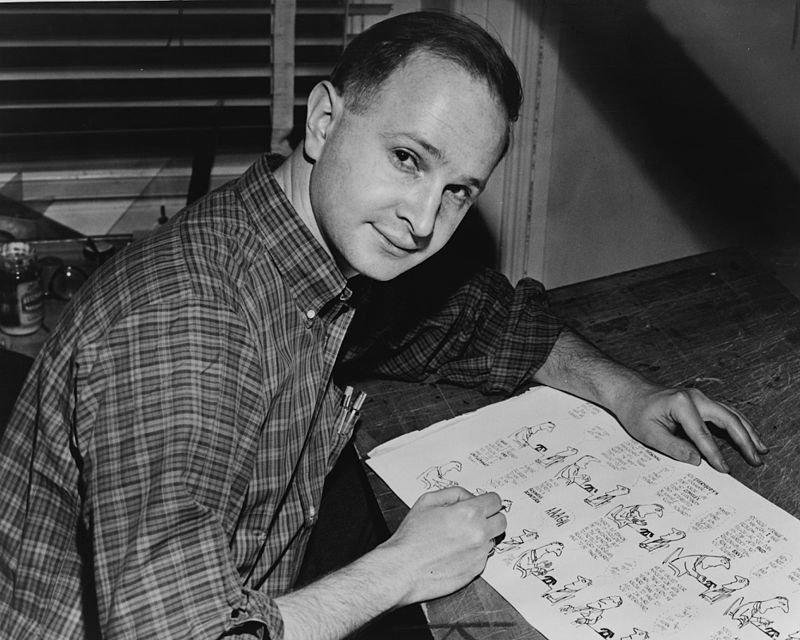| Media Type: |
Photograph |
| Art Type: |
Other |
| Artists: |
Jules Feiffer All
|
Jules Feiffer has had successful careers as playwright, screenwriter, and, lately, children’s book creator but remains best known for his Pulitzer Prize–winning weekly comic strip that ran in the Village Voice for 42 years. Initially entitled Sick Sick Sick, the strip captured the era’s zeitgeist with acerbic accuracy and mordant humor and was equally incisive in skewering political foibles and gender warfare. This chunky volume, the first of four in a complete edition, shows that Feiffer was at first finding his way visually, for early installments show the strong influences of cartoonist William Steig and UPA animated cartoons. It wasn’t long, however, before he developed the strip’s hallmark willowy look and balloonless dialogue. Such Eisenhower-era themes as nuclear fallout, bohemia, and jazz figure early on, to be joined by 1966 by pollution, unisex fashions, and, above all, Vietnam. Perusal of the hundreds of intervening cartoons discovers that, for all the strip’s contemporary relevance, intellectual pretensions, the banality of television, and miscommunication between the sexes never went out of style as targets of Feiffer’s satire. --Gordon Flagg
At The Village Voice (1956–1997)
After working with Eisner for nearly a decade, he chose to start creating his own comic strips. In 1956, after again first proving his talent by working for free, he became a staff cartoonist at The Village Voice where he produced the weekly comic strip titled Feiffer. Feiffer's strips ran for 42 years, until 1997, at first titled Sick Sick Sick, then as Feiffer's Fables, and finally as simply Feiffer. After a year with the Voice, Feiffer compiled a collection of many of his satire cartoons into a best-selling book, Sick Sick Sick: A Guide to Non-Confident Living (1958), a dissection of popular social and political neuroses. The success of that collection led to his becoming a regular contributor to the London Observer and Playboy magazine.
Director Stanley Kubrick, a fellow Bronx native, invited Feiffer to write a screenplay for Sick, Sick, Sick, although the film was never made. After first becoming aware of Feiffer's work, Kubrick wrote him in 1958:
The comic themes you weave are very close to my heart ... I must express unqualified admiration for the scenic structure of your "strips" and the eminently speakable and funny dialog ... I should be most interested in furthering our contact with an eye toward doing a film along the moods and themes you have so brilliantly accomplished.
Feiffer's cartoons were typically mini satires, where he portrayed ordinary people's thoughts about subjects such as sex, marriage, violence and politics.
By April 1959, Feiffer was distributed nationally by the Hall Syndicate, initially in The Boston Globe,Minneapolis Star Tribune, Newark Star-Ledger and Long Island Press. Eventually, his strips covered the nation, including magazines, and were published regularly in major publications such as the Los Angeles Times, The New Yorker, Esquire, Playboy and The Nation. He was commissioned in 1997 by The New York Times to create its first op-ed page comic strip, which ran monthly until 2000.
"His strip, usually six to eight borderless panels, initially appeared under the title Sick Sick Sick, with the subtitle 'A Guide to Non-Confident Living'. As the Lenny Bruce-ish language suggests, the earliest strips are very much of their time, the postwar Age of Anxiety in the big city; you can practically smell the espresso, the unfiltered ciggies, the lanolin whiff of woolly jumpers."
Feiffer published the hit Sick, Sick, Sick: A Guide to Non-Confident Living in 1958 (which featured a collection of cartoons from about 1950 to 1956), and followed up with More Sick, Sick, Sick and other strip collections, including The Explainers, Boy Girl, Boy Girl, Hold Me!, Feiffer's Album, The Unexpurgated Memoirs of Bernard Mergendeiler, Feiffer on Nixon, Jules Feiffer's America: From Eisenhower to Reagan, Marriage Is an Invasion of Privacy and Feiffer's Children. Passionella (1957) is a graphic narrative initially anthologized in Passionella and Other Stories, a variation on the story of Cinderella. The protagonist is Ella, a chimney sweep who is transformed into a Hollywood movie star. Passionella was used in a musical, The Apple Tree.
His cartoons, strips and illustrations have been reprinted by Fantagraphics as Feiffer: The Collected Works. Explainers (2008) reprints all of his strips from 1956 to 1966. David Kamp reviewed the book in The New York Times:
Biogaphy

|

|



